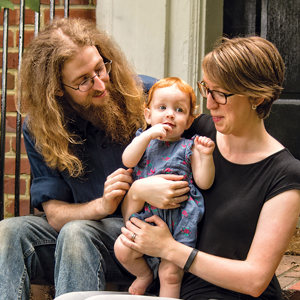At twenty-four, Richmonder Haley DeRoche was getting anxious. She had tried for a year to get pregnant with no results. Her doctor tested her and her husband for a variety of problems, but found none. Haley was told she had “unexplained infertility,” a frustrating answer to the increasingly common question: Why can’t I get pregnant? The next possible course of action for the young couple was in vitro fertilization (IVF). But the cost of IVF – about $10,000 per implant plus medications taken before the procedure, which can run up to $3,000 – was prohibitive. With those costs way out of the couple’s price range, they were worried they might never be able to have biological children.
They are not alone in that concern. According to the Society for Assisted Reproductive Technology, one out of every hundred babies born has had reproductive help of some kind to bring it from conception to successful delivery.
What’s behind these problems? Fertility issues can be numerous, including: low sperm count, ovulation dysfunction, polycystic ovarian syndrome, uterine fibroids, abnormal hormone levels, endometriosis, pelvic inflammatory disease, and irregular menstrual cycles, among others. Causes are linked to genetic, medical, and environmental factors. And, in over 40 percent of cases, no specific problem is identified (like Haley’s).
Fortunately for people who want to have babies, we now have incredible technology that can overcome many of these obstacles. Scientists and doctors can take eggs and fertilize them with sperm, check them for thousands of medical conditions or genetic issues, (including those that cause miscarriage), freeze them for use years in the future (in one case an embryo that had been frozen for ten years resulted in a successful pregnancy), or implant them in a want-to-be mom and bring them to full term. This process requires real commitment and work on the part of the medical providers and patients – and it is often prohibitively expensive for the latter.
Richard Lucidi, MD, is with the VCU Center for Advanced Reproductive Medicine and an associate professor in the department of OB/GYN reproductive endocrinology and infertility at Virginia Commonwealth University School of Medicine.
With regard to the most common causes of infertility, Dr. Lucidi says that age is the most critical factor. While IVF is successful about 50 percent of the time on the first try with women under thirty-five, the rate of success drops dramatically after that. In fact, a woman over age forty-two has less than a ten percent chance of getting pregnant, even with IVF.
Aside from the age factor, he adds that polycystic ovarian syndrome is the most common problem with women. For men, it is lack of viable sperm. Causes of polycystic ovarian syndrome are uncertain, but researchers believe abnormal hormone levels and possibly excess insulin production are factors. Where male sperm are concerned, there are numerous physical, hormonal, and environmental elements at work that can affect sperm health and count.
Dr. Lucidi says everyone is different. “When someone comes in under age thirty-five and she is having normal periods, we suggest they try [to conceive] for a year. If over thirty-five, we say to try for six months. But after that, we recommend tests based on their medical history.” These might include ovarian function, semen analysis, hormone levels including thyroid, and possibly ultrasound to look for cysts or blockages.

He also says that for many patients, the problems of infertility can be stressful and cause depression. Although it’s not easy, Dr. Lucidi suggests that patients try not to dwell on this issue while they are searching for answers. He often recommends that patients seek counseling from psychologists who specialize in treating patients with pregnancy or infertility-related issues. In addition, Resolve is a national organization that provides information and support to those trying to overcome infertility issues. From their website, resolve.org, you can connect with numerous local support groups.
In recent years, extraordinary gains have been made in the field of fertility treatment. Dr. Lucidi says the precise screening that can now be done with eggs and sperm helps specialists choose which eggs have normal chromosomes and those that are the healthiest. This helps cut down on the number of fertilized eggs implanted, because doctors know the chances of success with healthy eggs and sperm are so much higher. This, in turn, reduces the risk of multiple births. He also says that freezing techniques are so good that there is no need for immediate implantation. Frozen eggs may even implant with more success than fresh eggs because of the high amount of estrogen needed to stimulate ovulation.
Keirsten Williams is one of Dr. Lucidi’s patients. She has a 13-year-old from her first marriage, but she and her new husband wanted to have another child. After one year of trying, they sought help from Dr. Lucidi. Keirsten, a nurse in the neonatal unit at MCV, was aware of how successful IVF can be, but she also had concerns. “I have seen many premature multiple births from in vitro in the neo-natal unit and was worried that might happen to me.” Despite that, she was determined to try. Her husband was diagnosed with a low sperm count and so in vitro would be the only likely way she would get pregnant.
She says there is a lot involved. “I was working full-time, caring for my daughter, and had to schedule ultrasounds, other tests, and lots of bloodwork,” said Keirsten. When her ovaries did not respond initially, she went on hormone therapy which caused a temporary menopause. “That was an enlightening experience! I kept monitoring my body and took hormone shots every night. I only had to take off two days from work – the day they retrieved my eggs and the day they implanted the fertilized eggs.” Ten days later, they checked her hormone levels and Keirsten was pregnant.
She was lucky, the first implant was successful, and her baby is due this fall. The total cost was more than $15,000 but she and her husband feel it was well worth it.
Meanwhile, Haley and her husband checked out every possible avenue to get pregnant, but the cost was still beyond their reach. Then a friend of theirs went overseas to get the needed treatment, medicines, and IVF. The cost was only $3,000 per implant, exclusive of medications and travel.
Excited, they did some research and began to make arrangements. Their doctor here in the United States worked with a medical team in the Czech Republic, sending records and test results. Everything had to be planned around Haley’s ovulation schedule. “I made the plane reservations only one week before we flew!” Communication with English-speaking liaisons smoothed the process. Hailey was told they would need to spend at least two weeks there. “It all went well and I felt very comfortable and pleased with the treatment and medical care. I wound up with three viable embryos varying in grades of health.” Haley and her husband had to return to Richmond, so they left the country not knowing if the implant had worked.
Sometime after their return, tests showed that Haley was indeed pregnant. Little Winifred DeRoche was born in
July 2014.
One of the concerns that couples may have in going overseas for IVF is that their doctors here may not want to follow them as patients. But Dr. Lucidi has no concerns about that. “Of course I would be happy to work with patients who have done this.” He understands how the expense can be a barrier to many.
Haley DeRoche and her husband may be going back to Czechoslovakia someday and it won’t be just to see the sights. They left something very precious behind. One other embryo is in a cryo-storage facility near Prague. The family pays $400 a year to keep it safe. (It would be far more expensive to store it in the United States according to the DeRoches.) Haley says about their whole experience and their personal journey to parenthood, “You have to have a sense of adventure to do this. It’s very strange to be getting emails from a foreign country about my embryo. We went through a lot of hoops to make this happen. It’s emotionally tough, but well worth it.”
 Making Parenthood Possible
Making Parenthood Possible
When Chesterfield resident Jenn Nixon and her husband came up against a familiar obstacle in their quest to have a baby, a great idea was born: Why not solve the financial problems facing those unable to conceive using a combination philanthropic-entrepreneurial approach?
Two years ago, Jenn, who last month welcomed baby Zoë to the family using a surrogate, founded the Race to Parenthood, a nonprofit to help couples finance the extraordinary expenses of fertility treatments, surrogacy, and adoption.
How it works: This fall, interested couples will fill out applications sharing their infertility stories. “Anyone who needs financial help becoming a parent should apply,” says Jenn. “Whether they’re thinking about IVF, are looking at surrogacy, or considering adoption.” After reviewing the applications, the previous year’s Race to Parenthood couples decide who will participate in the 2016 fundraiser. Jenn says the applications (or infertility stories) are completely anonymous, so there is no bias in choosing the new participants.
After six couples are chosen, they’ll ask family members, friends, and others to register and run or walk in the 5K for a registration fee. Much like other fundraisers, teams are created to support the cause, in this case, the fertility-challenged couples. There are also a number of companies that provide sponsorship of the race costs. Those who do not want to actually run in the race can be virtual participants and still contribute. “This is perfect for out-of-town friends and family who want to help,” says Jenn.
In 2014, the Race to Parenthood raised over $28,600. The 2015 race raised more than $40,000. One hundred percent of the race registrations go directly to each couple based on participation from their respective supporters.
Since 2013, Jenn’s efforts have helped twelve couples get closer to achieving their dream of becoming parents. So far, three babies have resulted from race support in 2014 and 2015. The next race is scheduled for April 9, 2016. For more information, visit theracetoparenthood.com.
Jenn, who knows firsthand how financially and emotionally stressful infertility can be, says this is a wonderful way to “engage the people in your life in your quest to become a parent.”
She also has advice for those struggling with the challenges of trying to have biological children. She says, “It’s important to not give up, to keep working toward your goal. But do not put your happiness on hold while you are doing that.” She adds that life does not follow your plans and is often full of surprises. “If you wind up living a child-free life, you can still find happiness in other ways. Happiness should be your goal.”
Race photo courtesy Adams Bristow Photography.




